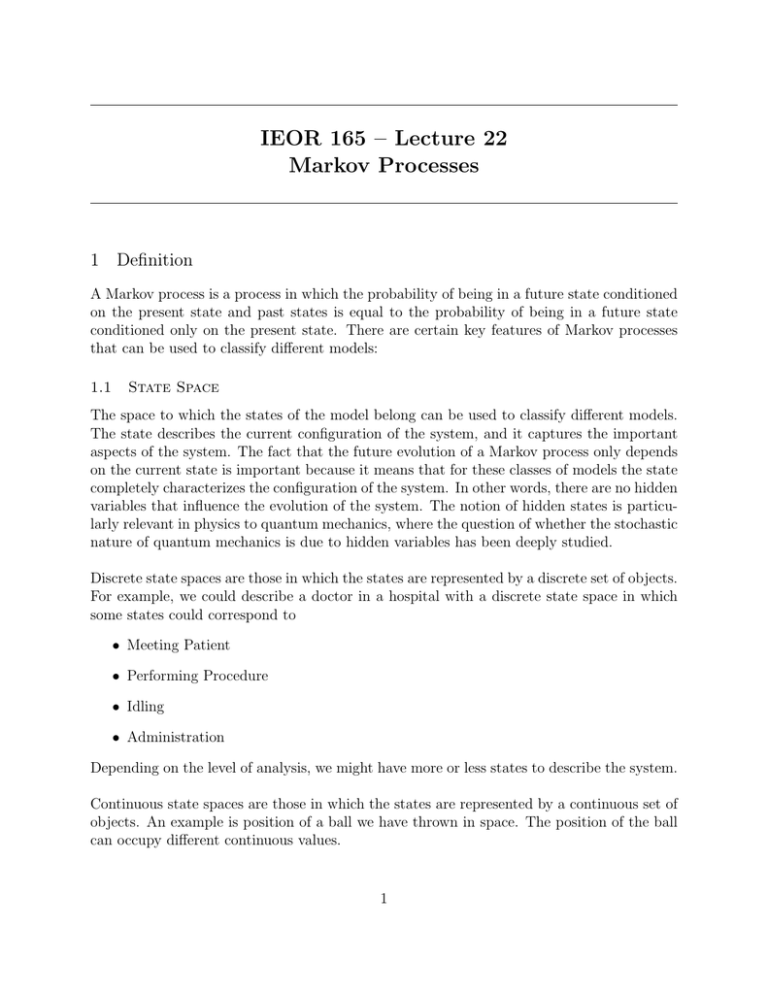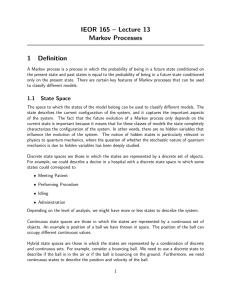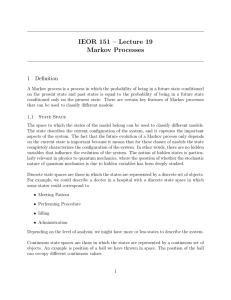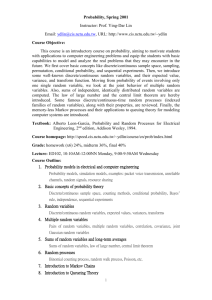IEOR 165 – Lecture 22 Markov Processes 1 Definition
advertisement

IEOR 165 – Lecture 22
Markov Processes
1 Definition
A Markov process is a process in which the probability of being in a future state conditioned
on the present state and past states is equal to the probability of being in a future state
conditioned only on the present state. There are certain key features of Markov processes
that can be used to classify different models:
1.1
State Space
The space to which the states of the model belong can be used to classify different models.
The state describes the current configuration of the system, and it captures the important
aspects of the system. The fact that the future evolution of a Markov process only depends
on the current state is important because it means that for these classes of models the state
completely characterizes the configuration of the system. In other words, there are no hidden
variables that influence the evolution of the system. The notion of hidden states is particularly relevant in physics to quantum mechanics, where the question of whether the stochastic
nature of quantum mechanics is due to hidden variables has been deeply studied.
Discrete state spaces are those in which the states are represented by a discrete set of objects.
For example, we could describe a doctor in a hospital with a discrete state space in which
some states could correspond to
• Meeting Patient
• Performing Procedure
• Idling
• Administration
Depending on the level of analysis, we might have more or less states to describe the system.
Continuous state spaces are those in which the states are represented by a continuous set of
objects. An example is position of a ball we have thrown in space. The position of the ball
can occupy different continuous values.
1
Hybrid state spaces are those in which the states are represented by a combination of discrete
and continuous sets. For example, consider a bouncing ball. We need to use a discrete state
to describe if the ball is in the air or if the ball is bouncing on the ground. Furthermore, we
need continuous states to describe the position and velocity of the ball.
1.2
Initial Conditions
To define the evolution of a Markov process, we need to specify an initial condition, which
represent the states of the system at the “start”. The initial condition can be stochastic or
deterministic. For instance, we can specify a distribution of states the system “starts” at.
1.3
Time
Two common classes of models are discrete-time and continuous-time models. In most
Markov processes, time is a privileged variable, meaning that it is interpreted as a clock that
keeps track of the duration between events; however, this is not the case in general. For
instance, special and general relativity models from physics drop time from this privileged
position in a precise way.
Discrete-time models are those in which time increases in discrete increments. Starting from
t = 0, time advances as t = t+1, and actions in this class of models occur at every increment.
Because of the discrete nature of time in this class of models, the time variable t is often
used as an index for the state-variables. So if, say, the state is x ∈ Rp , then the value of
the state at time t is denoted xt or x[t]. Because of the discrete nature of time, another
convention is to use the variables n or k to denote time.
Continuous-time models are those in which time continuously increases. Starting from t = 0,
time advances as dtd t = 1, and actions in this class of models can occur at any point in time.
Because of the continuous nature of time in this class of models, the time variable is used
as the input into a function describing the states. So if the state is x, then the value of the
state at time t is denoted as x(t).
These are not the only classes of models for temporal evolution. For instance, hybridtime models are those in which time increases in both discrete and continuous increments.
These types of models occur when describing certain semi-autonomous, robotic, or embedded
systems.
2 Discrete Time Markov Chains
A Markov chain is a Markov process in which the state space is discrete. Vertices are used as
an abstraction for different quantities/states of the system. For instance, we can use vertices
to represent the number of people waiting in the queue for a service system. The time in
this class of models can be continuous, discrete, or hybrid.
2
Because of the discrete nature of the state space, the system is represented by a weighted
directed graph G = (V, E), where the vertices vi ∈ V represent states of the system and the
edges eij ∈ E denotes an edge from vi going towards vj . Furthermore, every vertex vi has
a self-loop, meaning an edge eii ∈ E for all vi ∈ V . By convention, these self-loops are not
drawn because they have a fundamentally different characteristic.
The edges eij ∈ E for i ̸= j have strictly positive weights wij . For a discrete-time Markov
chain, the weight wij will represent the probability of a transition to state vj occurring when
the system is currently at state xi . In particular, if edge eij has weight wij then this means
that we have the following probability of transitioning states for all vi , vj ∈ V (even for
vi = vj ):
P[xt+1 = vj |xt = vi ] = wij .
2.1
MLE Estimator
Suppose we have data that consists of xt ∈ V for t = 0, . . . , n. The question we would
like to answer is how can we estimate the wij weights? One possible approach is maximum
likelihood estimation. Before we define the likelihood, it is useful to define the following
values
n−1
∑
Nij =
1(xt = vi and xt+1 = vj ).
t=0
These values count the number of transitions between vertices vi to vertices vj that were
observed in the measured data. Next, note that the likelihood is given by
P(xt for t = 0, . . . , n) = P(x0 ) · P[x1 |x0 ] · P[x2 |x1 , x0 ] · · · P[xn |xn−1 , . . . , x0 ]
= P(x0 ) · P[x1 |x0 ] · P[x2 |x1 ] · · · P[xn |xn−1 ]
= P(x0 ) ·
n−1
∏
P[xt+1 |xt ]
t=0
= P(x0 ) ·
∏∏
vi
N
wij ij
vj
We have used the Markov property in going from the first to second line, and the third line
comes by definition of the Nij values. Consequently, the MLE is given by
}
{
∏∏ N
∑
max P(x0 ) ·
wij ij |
wij = 1, ∀vi .
vi
vj
vj
The solution does not depend on P(x0 ), and so we can drop this term. To simplify the
calculation, we can take the negative log-likelihood. As a result, we solve
{
}
∑∑
∑
min −
Nij log wij |
wij = 1, ∀vi .
vi
vj
vj
3
The KKT conditions are
− Nij /wij + λi = 0, ∀vi , vj
∑
wij = 1, ∀vi
vj
This means that wij = Nij /λi . And so,
quently, our estimate is
∑
vj
Nij /λi = 1 implies that λi =
Nij
ŵij = ∑
.
vj Nij
4
∑
vj
Nij . Conse-





